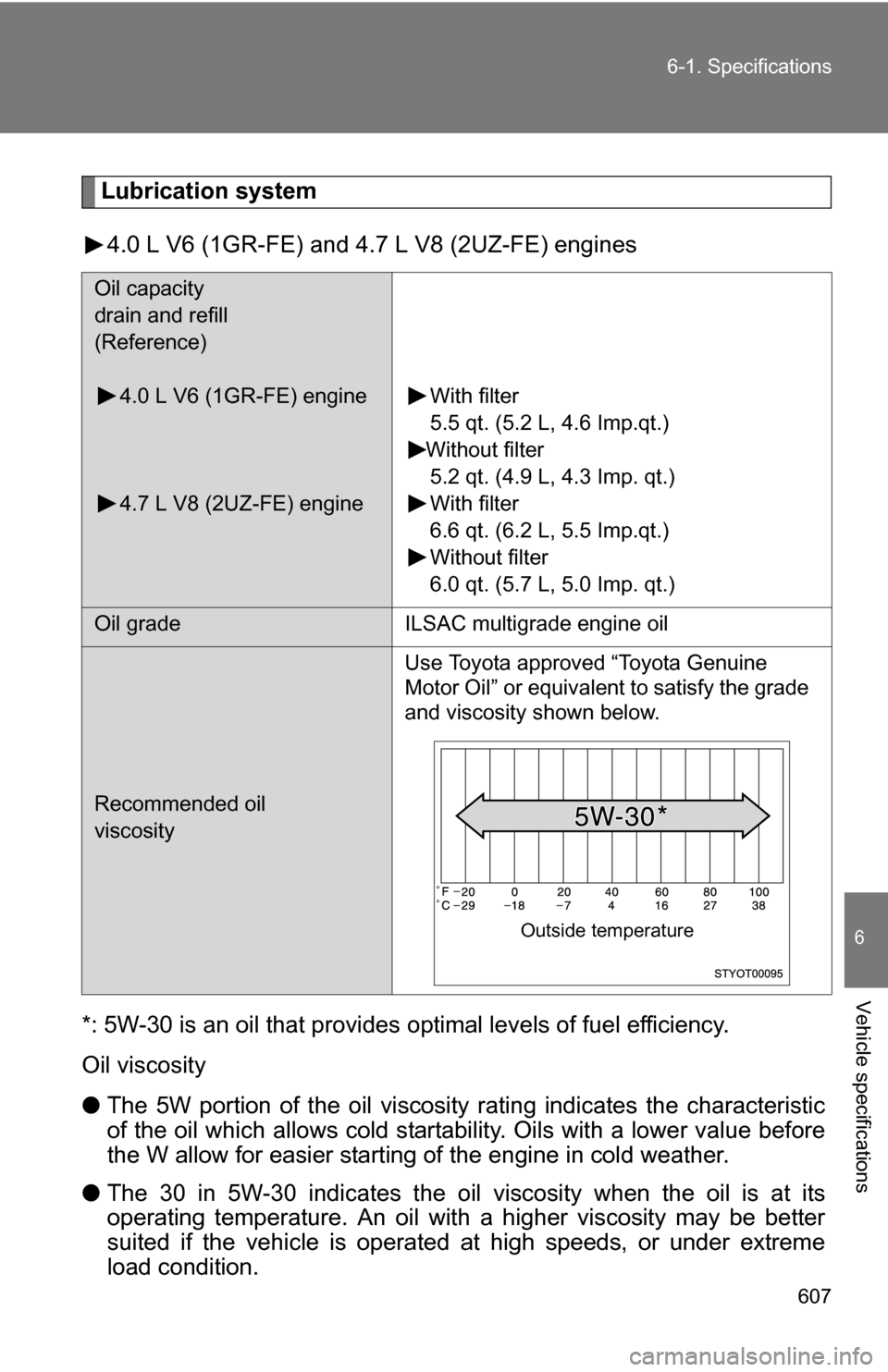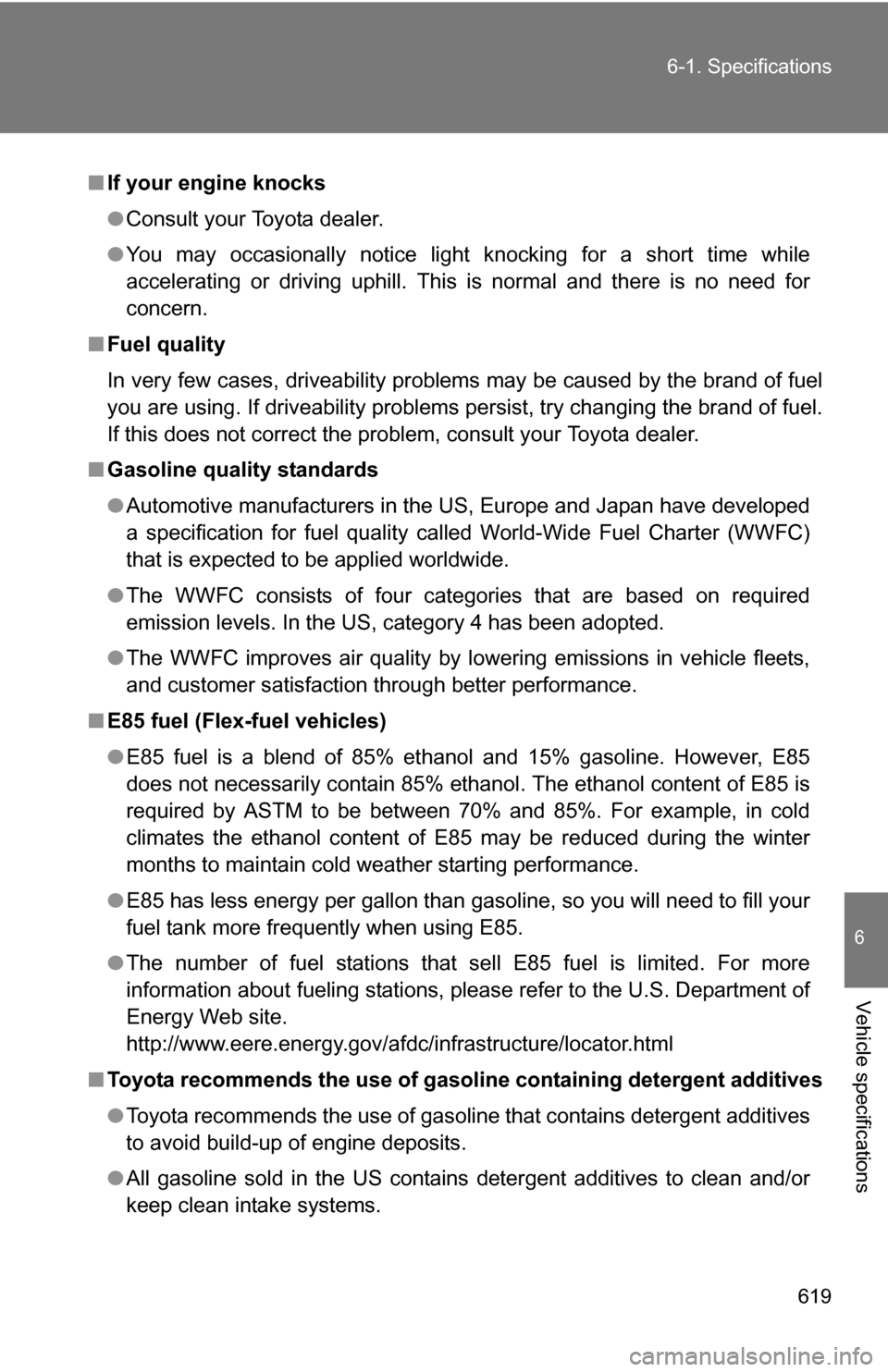Page 575 of 672

5
When trouble arises
575
5-2. Steps to take in an emergency
If the engine will not star t
If the engine still does not start after following the correct starting
procedure ( P. 177) or releasing the steering lock (P. 178), confirm
the following points.
■ The engine will not start even when the starter motor oper-
ates normally.
One of the following may be the cause of the problem.
●There may not be sufficient fuel in the vehicle’s tank.
Refuel the vehicle. (
P. 103)
Flex-fuel vehicles: The type of fuel may be different. When
refueling, add the same type of fuel, if available.
After adding a different type of fuel, the engine may run
roughly and driving performance may be reduced for a while
when the engine is first started. In this case, wait until the
engine runs normally.
● The engine may be flooded.
Try to restart the engine once more following correct starting
procedures.
● There may be a malfunction in the engine immobilizer system.
( P. 108)
■ The starter motor turns over slowly, the interior lights and
headlights are dim, or the horn does not sound or sounds at
a low volume.
One of the following may be the cause of the problem.
●The battery may be discharged. ( P. 581)
● The battery terminal connec tions may be loose or corroded.
Page 583 of 672

5
When trouble arises
583
5-2. Steps to take in an emergency
■
Starting the engine when the battery is discharged
The engine cannot be started by push-starting.
■ Avoiding a discharged battery
●Turn off the headlights and the audio system while the engine is turned
off.
● Turn off any unnecessary electrical components when the vehicle is run-
ning at a low speed for an extended period, such as in heavy traffic, etc.
■ When the battery is removed or discharged
●The moon roof must be initialized. ( P. 101)
● Flex-fuel vehicles: The information recorded in the computer will be
cleared, which may cause the engine to run roughly and reduce driving
performance for a while when the engine is first started. In this case, wait
until the engine runs normally.
If the vehicle is running on E85, the engine may stall.
In this case, restart the engine, repeatedly if necessary.
CAUTION
■Avoiding battery fires or explosions
Observe the following precautions to prevent accidentally igniting the flam-
mable gas that may be emitted from the battery.
●Make sure the jumper cable is connected to the correct terminal and that it
is not unintentionally in contact with any part other than the intended termi-
nal.
● Do not allow the jumper cables to come into contact with the “+” and “-” ter-
minals.
● Do not smoke, use matches, cigarette lighters or allow open flame near
the battery.
Page 589 of 672
Vehicle specifications6
589
6-1. Specifications................. 590Maintenance data (fuel, oil level, etc.) ......... 590
Fuel information ............... 618
Tire information ................ 622
6-2. Customization ................ 633 Customizable features ..... 633
Items to initialize .............. 636
Page 590 of 672
590
6-1. Specifications
Maintenance data (fuel, oil level, etc.)
Dimensions2WD models
*1: Unladen vehicle
*2: P255/70R18 tires
*3: P275/65R18 tires
*4: P275/55R20 tires
Cab type Regular Cab Double Cab
Bed type Standard Long Standard Long
Overall
length209.8 in.
(5330 mm) 228.7 in.
(5810 mm) 228.7 in.
(5810 mm) 247.6 in.
(6290 mm)
Overall width 79.9 in.
(2030 mm) 79.9 in.
(2030 mm) 79.9 in.
(2030 mm) 79.9 in.
(2030 mm)
Overall
height*1
75.9 in.
(1930 mm)*275.7 in.
(1925 mm)*275.9 in.
(1930 mm)*275.7 in.
(1925 mm)*2
75.7 in.
(1925 mm)*3,*475.5 in.
(1920 mm)*375.7 in.
(1925 mm)*3,*475.5 in.
(1920 mm)*3
Wheelbase 126.7 in.
(3220 mm) 145.6 in. (3700 mm) 164.5 in.
(4180 mm)
Front tread 67.9 in. (1725 mm)
Rear tread67.9 in. (1725 mm)
Page 606 of 672
606 6-1. Specifications
5.7 L V8 (3UR-FE, 3UR-FBE) engine
Fuel
Model3UR-FE, 3UR-FBE
Type 8-cylinder V-type, 4-cycle, gasoline
Bore and stroke 3.70 4.02 in. (94.0 102.0 mm)
Displacement 345.6 cu.in. (5663 cm3)
Drive belt tension Automatic adjustment
Valve clearance
(engine cold)
Intake
Exhaust Automatic adjustment
Engine
Gasoline engine Flex-fuel engine
Fuel typeUnleaded gasoline onlyUnleaded gasoline, E85,
or a blend of the two fuels
Octane rating
(Unleaded gasoline) 87 (Research octane number91) or higher
Ethanol percentage
(E85)
85% or less
Fuel tank capacity
(Reference) 26.4 gal. (100.0 L, 22.0 lmp.gal.)
Page 607 of 672

607
6-1. Specifications
6
Vehicle specifications
Lubrication system
4.0 L V6 (1GR-FE) and 4.7 L V8 (2UZ-FE) engines
*: 5W-30 is an oil that provides optimal levels of fuel efficiency.
Oil viscosity
● The 5W portion of the oil viscosity rating indicates the characteristic
of the oil which allows cold startab ility. Oils with a lower value before
the W allow for easier starting of the engine in cold weather.
● The 30 in 5W-30 indicates the oil viscosity when the oil is at its
operating temperature. An oil with a higher viscosity may be better
suited if the vehicle is operated at high speeds, or under extreme
load condition.
Oil capacity
drain and refill
(Reference)
4.0 L V6 (1GR-FE) engine
4.7 L V8 (2UZ-FE) engine With filter
5.5 qt. (5.2 L, 4.6 Imp.qt.)
Without filter 5.2 qt. (4.9 L, 4.3 Imp. qt.)
With filter
6.6 qt. (6.2 L, 5.5 Imp.qt.)
Without filter
6.0 qt. (5.7 L, 5.0 Imp. qt.)
Oil grade ILSAC multigrade engine oil
Recommended oil
viscosityUse Toyota approved “Toyota Genuine
Motor Oil” or equivalent to satisfy the grade
and viscosity shown below.
Outside temperature
Page 618 of 672

618
6-1. Specifications
Fuel infor mation
■Fuel tank opening fo r unleaded gasoline
To help prevent incorrect fueling, your Toyota has a fuel tank opening that
only accommodates the special nozzle on unleaded fuel pumps.
Gasoline engine
Your vehicle must use only unleaded gasoline.
Select octane rating 87 (Research Octane Number 91) or higher. The
use of unleaded fuel with an octa ne rating lower than 87 may result
in engine knocking. Persistent kno cking can lead to engine damage.
At minimum, the gasoline you use should meet the specifications
of ASTM D4814 in the U.S.A. and CGSB3.5-M93 in Canada.
Flex-fuel engine
Your vehicle must use only unleaded gasoline, E85, or a blend of the
two fuels.
Unleaded gasoline (Octane rating 87 [Research Octane Number 91]
or higher), E85, or a blend of these two fuels is required for optimum
engine performance.
The use of unleaded gasoline with an octane rating lower than 87
may result in engine knocking. Persistent knocking can lead to
engine damage.
The use of fuel with an ethanol concentration in excess of 85% will
have a negative impact on driv ing performance and can cause
damage to the fuel system components.
At minimum, the gasoline you us e should meet the specifications
of ASTM D4814 in the U.S.A. and CGSB3.5-M93 in Canada.
At minimum, the E85 you use should meet the specifications of
ASTM D5798 in the U.S.A.
Page 619 of 672

619
6-1. Specifications
6
Vehicle specifications
■
If your engine knocks
●Consult your Toyota dealer.
● You may occasionally notice light knocking for a short time while
accelerating or driving uphill. This is normal and there is no need for
concern.
■ Fuel quality
In very few cases, driveability problems may be caused by the brand of f\
uel
you are using. If driveability problems persist, try changing the brand of fuel.
If this does not correct the problem, consult your Toyota dealer.
■ Gasoline quality standards
●Automotive manufacturers in the US, Europe and Japan have developed
a specification for fuel quality called World-Wide Fuel Charter (WWFC)
that is expected to be applied worldwide.
● The WWFC consists of four categories that are based on required
emission levels. In the US, category 4 has been adopted.
● The WWFC improves air quality by lowering emissions in vehicle fleets,
and customer satisfaction through better performance.
■ E85 fuel (Flex-fuel vehicles)
●E85 fuel is a blend of 85% ethanol and 15% gasoline. However, E85
does not necessarily contain 85% ethanol. The ethanol content of E85 is
required by ASTM to be between 70% and 85%. For example, in cold
climates the ethanol content of E85 may be reduced during the winter
months to maintain cold weather starting performance.
● E85 has less energy per gallon than gasoline, so you will need to fill your
fuel tank more frequently when using E85.
● The number of fuel stations that sell E85 fuel is limited. For more
information about fueling stations, please refer to the U.S. Department of
Energy Web site.
http://www.eere.energy.gov/afdc/infrastructure/locator.html
■ Toyota recommends the use of gaso line containing detergent additives
● Toyota recommends the use of gasoline that contains detergent additives
to avoid build-up of engine deposits.
● All gasoline sold in the US contains detergent additives to clean and/or
keep clean intake systems.